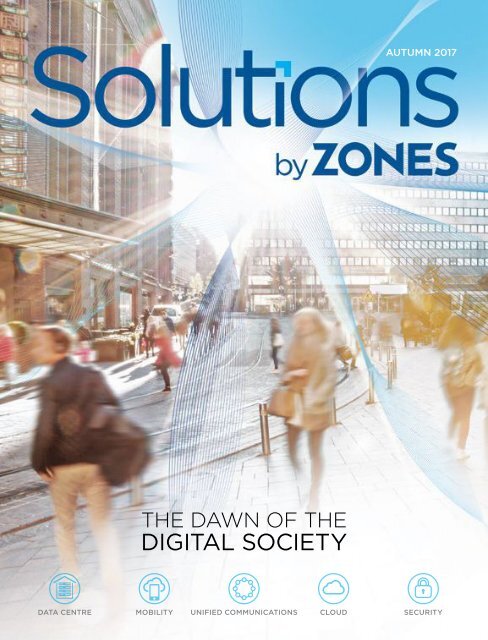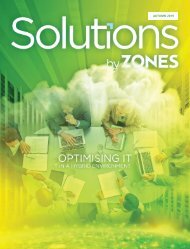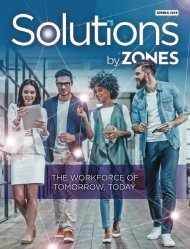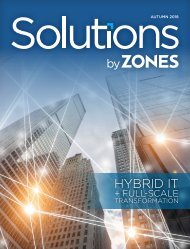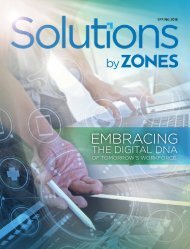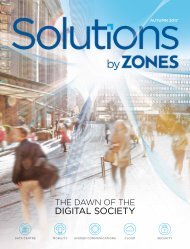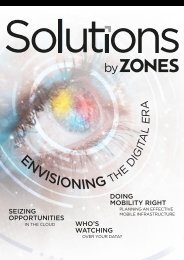SJ113 Master 2
You also want an ePaper? Increase the reach of your titles
YUMPU automatically turns print PDFs into web optimized ePapers that Google loves.
AUTUMN 2017<br />
THE DAWN OF THE<br />
DIGITAL SOCIETY<br />
DATA CENTRE MOBILITY UNIFIED COMMUNICATIONS CLOUD SECURITY
contents<br />
4<br />
Zones Data centre<br />
6<br />
Data centre<br />
14<br />
Unified Communications / Mobility<br />
6<br />
Data: When Is<br />
Enough, Enough?<br />
20<br />
20<br />
Security<br />
Who’s The New<br />
Grandmaster?<br />
26Cloud<br />
New to Zones and don’t have<br />
a dedicated account executive?<br />
Contact us at +44 (0) 207<br />
608 7676. Our IT experts are<br />
available and ready to work<br />
with you.<br />
Zones is a global provider<br />
of comprehensive IT solutions.<br />
We enable positive business outcomes through innovative<br />
solutions that leverage technology from best-of-breed partners<br />
and exceptional service from our team of certified sales,<br />
technical engineering, and supply chain specialists.<br />
14<br />
The information tsunami<br />
is just getting started.<br />
When ’’Phoning It In’’<br />
is Good for Business.<br />
Driving remote worker<br />
productivity and engagement.<br />
26<br />
Making the right moves to win<br />
the security challenge.<br />
Cloud-Minded.<br />
Business-Grounded.<br />
Forecasting a calm and clear<br />
business climate.<br />
2 Solutions by Zones Autumn 2017<br />
ukzones.com +44 (0) 207 608 7676 3
RIGHT AT THE<br />
HEART<br />
OF IT ALL.<br />
Information has become the most important<br />
component of doing business in the world today.<br />
Whether you’re collecting it, crunching it, streaming it,<br />
or sharing it, we put it at the heart of everything<br />
we do. So, no matter what your business is doing<br />
with it, one thing’s for sure, Data centre Solutions<br />
from Zones can help you do it better, faster, and<br />
safer than ever before.<br />
ZONES DATA CENTRE SOLUTIONS | LET’S TALK.<br />
UKZONES.COM<br />
+44 (0) 207 608 7676
DATA<br />
When Is Enough,<br />
Enough?<br />
In his 2005 book The Singularity<br />
Is Near: When Humans Transcend<br />
Biology, futurist Ray Kurzweil<br />
imagines a time when intelligence<br />
becomes nonbiological and far more<br />
powerful than ever before. Little more<br />
than a decade later, the continuing<br />
exponential progress of information<br />
technology has brought us to the<br />
point where we are indeed beginning<br />
to transcend biological limitations,<br />
stimulating creativity and enabling<br />
new paradigms of work, thought,<br />
and even life.<br />
To understand the exponential<br />
progress of information technology,<br />
think for a moment about the<br />
accelerating timeline of technological<br />
progress over the past 52 years since<br />
Fairchild Semiconductor’s (and later<br />
Intel co-founder) Gordon Moore
The Silicon Engine<br />
1950s<br />
Silicon<br />
Transistor<br />
1<br />
Transistor<br />
A Timeline of Semiconductors<br />
1990s<br />
32-bit<br />
Microprocessor<br />
3,100,000<br />
Transistors<br />
1960s<br />
TTL<br />
Quad Gate<br />
16<br />
Transistors<br />
plotted a handful of data points<br />
that tracked the increasing number<br />
of integrated circuits that could be<br />
placed on a single chip.<br />
Based on just five data points dating<br />
back to 1959, Moore found that it<br />
was taking approximately a year for<br />
engineers to double the number of<br />
computing elements per chip. As<br />
additional data was gathered over<br />
time, the time period for doubling<br />
was revised to two years, establishing<br />
Moore’s Law. And so it continued.<br />
When Intel launched its first<br />
microprocessor, the 4004 in 1971,<br />
64-bit<br />
Microprocessor<br />
592,000,000<br />
Transistors<br />
1970s<br />
8-bit<br />
Microprocessor<br />
4500<br />
Transistors<br />
2010s<br />
3072-Core<br />
GRU<br />
8,000,000,000<br />
Transistors<br />
Photo credits: Fairchild Camera and Instrument Corporation, Intel Corporation<br />
(Note that images are not to scale), Nvidia Corporation<br />
1980s<br />
32-bit<br />
Microprocessor<br />
275,000<br />
Transistors<br />
2,300 transistors were jam-packed<br />
onto a 12-square-millimeter chip.<br />
Compare that with the 3.2 billion<br />
transistors on Intel’s 10-core Core i7<br />
Broadwell-E processor today,<br />
and you begin to understand the<br />
scale of exponential acceleration.<br />
It seems incredible that Moore’s<br />
Law has held true over the decades,<br />
but it has. Time after time, as the<br />
limitations of processor design and<br />
manufacturing technology seemed<br />
likely to derail it, new advances put<br />
his theory right back on track.<br />
How did this happen? In a word:<br />
technology. As engineers shifted<br />
design from slide rules and paper to<br />
electronic calculators to CAD systems,<br />
the chips in those devices enabled<br />
breakthroughs in subsequent chip<br />
designs. Likewise, those advanced<br />
and advancing processors enabled<br />
manufacturing technologies to<br />
produce ever-smaller circuits<br />
on silicon.<br />
Will Moore’s Law continue to hold?<br />
That’s the subject of some debate in<br />
our industry right now. But if history<br />
is any guide, it’s likely that technology<br />
will continue to enable exponential<br />
growth – in ways that are today<br />
still unimaginable.<br />
Whether processing power continues<br />
to double on a regular schedule<br />
may be a moot point, however.<br />
From a utility standpoint, we are<br />
now operating with a vast amount<br />
of computing power. How we use<br />
available computing power is<br />
becoming more and more interesting<br />
than how much we will actually have<br />
in the future.<br />
Transistor density<br />
on integrated circuits<br />
doubles about<br />
every two years.<br />
Source: “Moore’s Law: Rising the<br />
Bar” (Intel Corporation, 2005)<br />
My, how you<br />
have grown.<br />
An interesting way to think about<br />
exponential growth is to contrast it<br />
with linear growth.<br />
Let’s say you have a stride of 3 feet,<br />
and you take a walk. Ten strides into<br />
your walk, you’re 30 feet from<br />
your starting point at a rate of 3-feetper-stride.<br />
And, it’s easy to predict<br />
where you’d be after 10 more steps.<br />
Now imagine that you could double<br />
the distance of your stride with each<br />
step. That would mean that after 10<br />
strides, you’d be over 3,000 feet from<br />
your starting point.<br />
That’s the almost unimaginable<br />
change that exponential growth can<br />
deliver. And what makes imagining<br />
exactly where we’re headed so<br />
difficult. We simply tend not to think<br />
in exponential terms in most aspects<br />
of our lives.<br />
Today, data flows through our lives at<br />
an incredible rate.<br />
Our cars, once marvels of mechanical<br />
engineering, have been transformed<br />
into computers on wheels. And that<br />
smartphone in your pocket? It’s got<br />
more processing power than the<br />
Apollo command modules that took<br />
people to the moon and back.<br />
Right now in data centres and labs<br />
all around the world, the ability to<br />
crunch mountains of data is enabling<br />
exponential growth in 3D printing,<br />
virtual reality, automation, robotics,<br />
artificial intelligence (AI), and genetic<br />
science – all of which stand to<br />
dramatically affect the quality and<br />
longevity of life itself.<br />
The power of accelerating technology<br />
to shape the future is staggering.<br />
Consider that the first human<br />
genome was sequenced in 2004 at a<br />
cost of approximately $2 billion; less<br />
than the projected cost of $2.3 billion,<br />
and two years ahead of the schedule<br />
established in 1990.<br />
While truly groundbreaking at the<br />
time, technological and scientific<br />
advancements in the interim mean<br />
that today the same feat can be<br />
accomplished in 26 hours at a cost<br />
of about £800. Researchers are<br />
exploiting those massive time and<br />
cost reductions to identify specific<br />
mutations and develop highly<br />
personalised treatments for cancer<br />
patients.<br />
As you can see, exponential<br />
technological evolution is not<br />
limited to processors. Every related<br />
technology is riding a wave of<br />
astonishing progress. Storage capacity<br />
and data transmission rates – both<br />
wired and wireless – continue to grow<br />
exponentially as well. And the ability<br />
of evolving technology to speed the<br />
development of next-generation – or<br />
entirely new – technologies ensures<br />
that it will continue. The result is an<br />
ever-increasing availability of more<br />
data to more people in more places,<br />
and at lower cost, fueling further<br />
innovation in every field.<br />
In 2001, Kurzweil wrote that the<br />
overall rate of progress was doubling,<br />
“We won’t experience 100 years of<br />
progress in the 21st century – it will<br />
be more like 20,000 years of progress<br />
(at today’s rate).” And it would be<br />
wise to heed the forecasting abilities<br />
of a man who predicted in 1990 that<br />
a computer would beat a master<br />
chess player by 1998. After all, it<br />
happened on May 11, 1997, when<br />
IBM’s Deep Blue beat grandmaster<br />
Gary Kasparov in a six-game match.<br />
Fourteen years later, in 2011, Deep<br />
Blue’s descendant Watson took on<br />
two of the game show Jeopardy’s<br />
greatest champions and beat them<br />
both over three nights.<br />
Taking a turn<br />
for the better.<br />
Perhaps our native disinclination to<br />
think in terms of exponential growth<br />
is why we hear so much about – and<br />
why we experience – “disruption” in<br />
so many aspects of business today.<br />
A business model like Uber’s<br />
simply could not exist before the<br />
smartphone, so there’s really no way<br />
anyone could have anticipated its<br />
utility or popularity in 2007, when<br />
Apple introduced the iPhone. It’s not<br />
fair to say that taxi and private hire<br />
companies were caught napping,<br />
because Uber was truly revolutionary<br />
– not evolutionary – in leveraging<br />
newly available geolocation and cloud<br />
technologies to transform an industry.<br />
It’s no wonder the company<br />
has become the poster child for<br />
disruption.<br />
Today, we are all beneficiaries of<br />
the technologies that enable such<br />
disruption. The cost of computing<br />
power, storage, and networking<br />
have fallen almost as quickly as their<br />
capacities have increased.<br />
Think about the early PCs, they had<br />
no onboard storage. Instead you<br />
inserted a (truly) floppy disk with a<br />
8 Solutions by Zones Autumn 2017<br />
ukzones.com +44 (0) 207 608 7676 9
capacity of a few kilobits and went<br />
to work. Apple’s first hard drive, the<br />
ProFile offered 5MB of storage for<br />
£2,700. That’s £540 per MB. Today,<br />
you can run to your local PC World<br />
and pick up a 512GB memory card<br />
– that’s 500,000MB – for the princely<br />
sum of £330 or £0.001 per MB.<br />
The same price for performance<br />
declines hold true across the<br />
technology landscape. In 2017, we<br />
think nothing of the computing<br />
power we hold in our hands, deploy<br />
in our data centres, or access in the<br />
cloud.<br />
We can expect increasingly easy<br />
access to data that will drive change<br />
in our business and personal lives,<br />
too.<br />
Advances in miniaturisation and highspeed<br />
wireless networking mean the<br />
mobile revolution is just beginning.<br />
It’s not hard to imagine that devices<br />
the size of an Apple Watch will soon<br />
have the utility of a home office. And<br />
advances in voice recognition mean<br />
we won’t need to interact with that<br />
tiny screen, we’ll just have to speak<br />
and listen.<br />
Cybersecurity experts are embracing<br />
machine learning, as well, in a game<br />
of leapfrog that pits the black hats’<br />
algorithms against those of the good<br />
guys (see article on page 20).<br />
Big data – and the information<br />
derived from it – is yet another result<br />
of the shrinking cost and growing<br />
availability of massive computing<br />
power and storage capacity. For<br />
example, in medicine, machines can<br />
now scan and compare thousands of<br />
images to spot anomalies, leading to<br />
faster diagnoses. Police departments<br />
can use big data to identify patterns<br />
of activity and deploy resources more<br />
quickly to respond to or even deter,<br />
criminal activity. And businesses can<br />
sift through unlimited amounts of<br />
customer and sales data to identify<br />
triggers and opportunities in the<br />
marketplace.<br />
Cheap data is also driving the rapid<br />
evolution of machine learning. Every<br />
day we interact with algorithms that<br />
determine what we see online – from<br />
friend recommendations on Facebook<br />
to purchase suggestions on Amazon<br />
to the ads that pop up in almost all<br />
our browsers. These machine learning<br />
systems create models based on<br />
existing information and then make<br />
predictions and decisions based on<br />
new data. In other words, they “learn.”<br />
Transform Your<br />
IT Infrastructure<br />
Streamlined, flexible, transformative IT helps<br />
deliver the applications and workloads to<br />
make your business better. FlashStack<br />
dramatically reduces IT overhead and helps<br />
you drive business impact:<br />
Scale, upgrade, avoid downtime with<br />
stateless technology<br />
It’s likely that soon, big data, machine<br />
learning, and nanotechnology –<br />
the manipulation of individual<br />
atoms and molecules – will come<br />
together to address the subtitle<br />
of Kurzweil’s book, When Humans<br />
Transcend Biology.<br />
In the not too distant future, we can<br />
expect microscopic smart machines to<br />
help us fight disease, and allow us to<br />
experience the exponential growth of<br />
technology well into old age.<br />
Management design for the data centre<br />
and the business<br />
Promote innovation through simplified<br />
upgrades<br />
Designed around performance and<br />
reliability<br />
Simplicity, ease-of-use, and cost<br />
reducation<br />
For more information, visit<br />
www.ukzones.com
SERVICES. DELIVERED.<br />
Anything you can do, you can do better.<br />
iPad Pro<br />
INTEGRATION<br />
SERVICES<br />
LOGISTICS<br />
SERVICES<br />
DEPOT AND<br />
ASSET DISPOSAL<br />
(ITAD) SERVICES<br />
PROJECT<br />
MANAGEMENT<br />
SERVICES<br />
Immensely powerful, portable, and capable, iPad Pro features the redesigned Retina<br />
display that is the most advanced on the planet, while the A10X Fusion chip delivers<br />
more power than most PC laptops. With Apple Pencil, the Smart Keyboard, and iOS -<br />
the most advanced mobile operating system ever - iPad Pro is designed for the world<br />
we live in today.<br />
With Zones and Apple, unlock an entirely new world of mobility, or empower<br />
employees with more creative and compelling ways to work.<br />
UKZONES.COM +44 (0) 207 608 7676<br />
© Apple, the Apple logo, iPad, iPhone, Mac and OS X are trademarks of Apple Inc., registered in the U.S. and other countries.
When “phoning it in”<br />
is good for business.<br />
Driving remote worker<br />
productivity & engagement.<br />
Remote working. Love it or hate it, working from home (WFH)<br />
is here to stay.<br />
Sure, Yahoo’s Marissa Mayer brought (almost) everyone back<br />
on campus when she took the reins in 2013, but there’s little<br />
evidence that the move slowed the company’s decline. And<br />
for every Yahoo, there’s a Ctrip, the Chinese travel website that<br />
measured a 13.5 percent increase in calls made by its remote<br />
workers, versus its on-site office workers.<br />
That kind of increase represents almost a full day’s worth of<br />
productivity added to the bottom line for every remote worker<br />
each week. Maybe that’s why Amazon recently announced its<br />
plan to add 5,000 remote customer service positions over<br />
the next year.<br />
And while quantifying productivity for many roles won’t be as<br />
easy as tracking call volume, it’s a safe bet that your operation<br />
could see a similar boost in productivity – and morale – by<br />
embracing it.<br />
One thing’s for sure – you’re likely to see a larger pool of<br />
qualified applicants for open positions more quickly. When you<br />
remove geographic barriers, you can tap into talent that would<br />
not consider moving to your city for any number of reasons.<br />
Depending on your location and that of applicants, this could<br />
result in paying less to fill those positions.<br />
ukzones.com +44 (0) 207 608 7676 15
Flexible.<br />
Convenient.<br />
Sustainable.<br />
Eliminating the regular commute for<br />
workers costs employers little but<br />
gives team members something of<br />
immense value: time.<br />
Trimming 30 minutes to 4 hours<br />
of commuting time from workers’<br />
daily routines is essentially a no-cost<br />
benefit the organisation can leverage<br />
to attract and retain talent in urban<br />
and rural areas alike. And rest assured,<br />
the perceived value of this benefit to<br />
workers is extremely high.<br />
Beyond perceived value, WFH<br />
arrangements also deliver real savings<br />
to workers in the form of reduced<br />
commuting expenses. An employee<br />
commuting 40 miles roundtrip in a<br />
car getting 20 mpg stands to save<br />
almost £10 a day in petrol alone, not<br />
to mention wear-and-tear on the<br />
car, tolls, and parking fees. Likewise,<br />
transit costs are substantially reduced<br />
or altogether eliminated.<br />
It’s not only the team members<br />
who stand to benefit financially.<br />
A well-planned WFH initiative can<br />
substantially reduce the need for office<br />
space. On those days when remote<br />
workers need to be in the office for<br />
meetings, they can be accommodated<br />
in a much smaller hoteling space than<br />
would be acceptable to them if they<br />
had to call it “home” five days a week.<br />
And, if you look at the big picture, WFH<br />
impacts sustainability as well. Fewer<br />
commuters means fewer emissions and<br />
less traffic on area roadways.<br />
In fact, a study by the Telework<br />
Research Network calculated that if<br />
all of the 45 percent of U.S. workers<br />
holding at least part-time WFHcompatible<br />
jobs worked at home two<br />
to four days a week, we could see a<br />
reduction in greenhouse gases of up<br />
to 51 million tons – the equivalent of<br />
taking almost 11 million cars off the<br />
road for a year.<br />
Work on your<br />
terms.<br />
It’s no surprise that some employers<br />
confuse presence with productivity.<br />
But as most people can attest, some<br />
people who show up to the office<br />
every day are not giving it their all.<br />
Whether that’s because of poor<br />
work habits or<br />
distraction due to<br />
work/life balance<br />
issues is hard to<br />
know, but a welldesigned<br />
WFH<br />
arrangement can<br />
greatly reduce<br />
the stress of<br />
maintaining<br />
balance between<br />
work and parental or caregiver<br />
responsibilities. And reducing<br />
negative stress is<br />
proven to raise productivity.<br />
Enabling such productivity in<br />
the workplace has been dubbed<br />
“productive mobility.”<br />
Productive mobility is achieved<br />
through technology that enhances<br />
Enabling such<br />
productivity in<br />
the workplace<br />
has been dubbed<br />
“productive<br />
mobility.”<br />
the work experience outside of<br />
the physical office. Not too long<br />
ago, such enabling technology was<br />
limited to a laptop computer and a<br />
BlackBerry. While that did contribute<br />
to better work/life balance, it could<br />
also contribute to a degree of<br />
disconnectedness between remote<br />
workers and their teams or managers.<br />
Today, a well-crafted WFH/productive<br />
mobility plan can include a range of<br />
technologies that keeps everyone<br />
in the organisation connected and<br />
(sometimes literally) on the same<br />
page. At a minimum, you can bet<br />
that plan will include cloud-based<br />
sharing and collaboration tools, as<br />
well as presence functionality that lets<br />
everyone on the team know who’s<br />
online and available at all times.<br />
At Zones, we’re seeing greater<br />
demand<br />
for mobility<br />
solutions that<br />
streamline<br />
the transition<br />
from working<br />
in the office to<br />
working from<br />
home.<br />
One of the most<br />
important areas for consideration<br />
is how people communicate. If<br />
remote workers can conduct their<br />
day-to-day interactions in ways that<br />
are similar to how it’s done in the<br />
office, everyone benefits. If face-toface<br />
meetings are essential, a highquality<br />
videoconferencing solution<br />
may be what you need to maintain<br />
interpersonal connections.<br />
Our Mobility and Unified<br />
Communications teams are experts<br />
at helping businesses develop robust<br />
solutions that<br />
marry hardware,<br />
software, security<br />
protocols, and the<br />
cloud to enable<br />
dispersed workers<br />
to collaborate<br />
effectively,<br />
wherever they<br />
need to be.<br />
Sparking greater<br />
collaboration.<br />
Cisco is doing an excellent job of<br />
facilitating WFH initiatives – and<br />
collaboration in general – with its<br />
enterprise-grade on-premises, cloud,<br />
and hybrid collaboration tools.<br />
The company’s Business Edition<br />
platforms provide end-to-end unified<br />
communications capabilities including<br />
voice, video, conferencing, messaging,<br />
instant messaging, and presence.<br />
To extend the value of on-premises<br />
unified communications and<br />
collaboration investments, many<br />
organisations are turning to Zones<br />
and Cisco Spark Hybrid Services. Cisco<br />
Spark Hybrid Services connect what<br />
you have on-premises with Cisco Spark<br />
in the cloud. This gives businesses<br />
even greater collaboration capabilities,<br />
along with consistent, unified end-user<br />
and administrator experiences.<br />
With Cisco Spark Hybrid Services in<br />
place, all your users – remote and<br />
on-site – get a simple, secure space<br />
to get things done from anywhere<br />
they work. Using virtually any device,<br />
teams can activate the Spark app to<br />
screen share,<br />
white board,<br />
and create<br />
dedicated<br />
spaces to keep<br />
the conversation<br />
moving forward,<br />
regardless of<br />
where they are.<br />
... a high-quality<br />
videoconferencing<br />
solution can<br />
maintain critical<br />
interpersonal<br />
connections.<br />
Similarly,<br />
Microsoft’s Skype for Business delivers<br />
enhanced collaboration and powerful<br />
video-conferencing capabilities that<br />
can radically boost engagement<br />
among remote workers.<br />
Plan for<br />
productivity.<br />
Of course, no discussion about<br />
WFH-optimised infrastructure would<br />
be complete without addressing<br />
the devices that workers will actually<br />
use. While most current desktops,<br />
notebooks, and tablets have the<br />
connectivity, processing power, and<br />
memory necessary to work remotely,<br />
you’d be wise to consider the<br />
latest models if you want to access<br />
every available feature of today’s<br />
collaboration solutions.<br />
In a Windows environment, that<br />
means stepping up to Windows 10<br />
devices equipped with Intel ® 7th<br />
Generation Core processors. The<br />
reason for moving to 7th Generation<br />
– or “Kaby Lake” processors – is<br />
twofold.<br />
First, Microsoft will end extended<br />
support for Windows 7 in July 2020;<br />
the less ubiquitous Windows 8.1 will<br />
see extended support until 2023.<br />
Second, while 6th Generation Intel<br />
Core Processors will run Windows 10,<br />
7th-Generation-equipped devices<br />
won’t run Windows 7 or 8.1. That<br />
means you risk either OS or device<br />
obsolescence in the not too distant<br />
future if you continue to invest in<br />
6th Generation processors.<br />
If you’re running Office 365 with OS X<br />
devices, you should be in good shape<br />
for the foreseeable future.<br />
Out with the old.<br />
In with Zones.<br />
As in so many aspects of life today,<br />
technology continues to make the old<br />
way of doing things obsolete. And<br />
while face-to-face communication will<br />
continue to provide particular nuance<br />
to business relationships, the benefits<br />
of remote work – economic, personal,<br />
and societal – are becoming too<br />
compelling to ignore.<br />
If you’re thinking about implementing<br />
a WFH initiative within your<br />
organisation, let us know. We’re<br />
ready to put together a team of IT<br />
professionals who can evaluate your<br />
existing infrastructure. We’ll guide<br />
you through the process of deploying<br />
a productive solution that keeps<br />
your people working effectively and<br />
efficiently – no matter where they<br />
may be.<br />
16 Solutions by Zones Autumn 2017<br />
ukzones.com +44 (0) 207 608 7676 17
Dell recommends Windows 10 Pro.<br />
BEAUTY WITHOUT BORDERS.<br />
FASTER OUTCOMES. SIMPLER IT. REAL RESULTS.<br />
Converged and hyper-converged solutions that can deliver up to:<br />
36%<br />
LOWER<br />
IT COSTS 1<br />
55%<br />
FASTER APP<br />
DEVELOPMENT 1<br />
3X<br />
MORE TIME FOR<br />
IT INNOVATION 1<br />
36%<br />
LOWER<br />
IT COSTS 1<br />
The XPS 13 2-in-1 with an InfinityEdge display gives you a virtually borderless view<br />
and gorgeous detail, all on the world’s smallest 13-inch 2-in-1.<br />
With 7th Gen Intel ® Core i5 processor.<br />
Learn more at www.ukzones.com<br />
Intel Inside ® . Powerful<br />
Productivity Outside.<br />
The #1 Converged Portfolio 2 from Dell EMC<br />
with Intel ® Xeon ® processors delivers results.<br />
Learn more at DellEMC.com/CI<br />
Intel Inside ® .<br />
New Possibilities<br />
Outside.<br />
Intel, the Intel logo, Xeon, and Xeon Inside are trademarks or registered trademarks of Intel Corporation in the U.S. and/or other countries. All other trademarks used herein<br />
are the property of their respective owners. © Copyright 2017 Dell Inc. All rights reserved.<br />
1<br />
IDC, The Business Value of VCE Vblock Systems: Leveraging Convergence to Drive Business Agility, May 2015 https://www.emc.com/collateral/vce/idc-business-valuewhitepaper.pdf.<br />
2<br />
Based on Dell EMC revenue, December 2016.<br />
© 2017 Dell Inc. All rights reserved. Dell, the DELL logo, the DELL badge and XPS are trademarks of Dell Inc. Ultrabook, Celeron, Celeron Inside, Core Inside, Intel, Intel Logo, Intel<br />
Atom, Intel Atom Inside, Intel Core, Intel Inside, Intel Inside Logo, Intel vPro, Itanium, Itanium Inside, Pentium, Pentium Inside, vPro Inside, Xeon, Xeon Phi, and Xeon Inside are<br />
trademarks of Intel Corporation in the U.S. and/or other countries.
Who’s The New<br />
Grandmaster?<br />
Making the right moves to win the security challenge.<br />
This year marks the 20th anniversary of<br />
the final match game between chess<br />
champion Garry Kasparov and the IBM<br />
supercomputer Deep Blue. The world<br />
watched as Kasparov became the first<br />
world champion to be defeated in a<br />
match by a machine. The loss sparked<br />
the debate of “man versus machine” in<br />
the digital age.<br />
Fast-forward to the present, and the debate continues.<br />
Only now, we’re talking about machine learning too.<br />
But this is well-established technology. So, why all the<br />
interest? The answer is simple – machine learning requires<br />
a vast amount of data to come up with a simple answer.<br />
We’ve now reached the digital tipping point – big data.<br />
In addition, improvements to current technologies are<br />
being fueled by reduced hardware and software costs,<br />
and advancements in machine learning research and<br />
development.<br />
At the fast rate big data is growing, the demand for security<br />
intelligence also grows. While machine learning is being<br />
used in positive ways, it’s also being used for security<br />
breaches, too. So, what happens when two systems – hacker<br />
and enterprise – using machine learning meet up in a<br />
match of wits?<br />
ukzones.com +44 (0) 207 608 7676 21
5 Ways Machine Learning<br />
Can Be Used for Security<br />
During 2016, we had a record high of 1,093 breaches, according to<br />
the Identify Threat Resource Center. Don’t let your business become<br />
a statistic. Machine learning is being applied to five new areas with<br />
hopes that this capability can catch threats before they result in<br />
major security incidents.<br />
Do you enjoy being<br />
the new Grandmaster?<br />
Learning<br />
security moves.<br />
When a hacker’s system which is<br />
capable of machine learning goes up<br />
against an enterprise system, there’s<br />
a battle between security know-how.<br />
And, when data centre security is<br />
also learning defensive moves, there<br />
can be a chaotic and rapid exchange<br />
of strategic moves. That is, until<br />
someone wins.<br />
Briefly, machine learning is a series<br />
of techniques used to “train” a<br />
machine how to solve a problem.<br />
Although, there’s been a lot of “new”<br />
hype around machine learning, it’s<br />
currently being used now in several<br />
industries. Common applications<br />
of machine learning in technology<br />
include voice recognition, fraud<br />
detection, email spam filtering, search<br />
recommendations, and video analysis.<br />
So, chances are you’ve already seen<br />
machine learning in action.<br />
You’re most likely already using<br />
machine learning as part of your<br />
data centre security protection.<br />
Today’s defense solutions are<br />
optimised to prevent targeted attacks,<br />
advanced threats, and malware<br />
from embedding or spreading<br />
within a data centre or network. For<br />
example, at Zones we offer Trend<br />
Micro’s solution that can analyse<br />
unknown threats with machine<br />
learning algorithms to make real-time<br />
decisions on whether network traffic<br />
is malicious or benign.<br />
Zones also provides solutions that<br />
protect enterprises from attack<br />
methods that no one has ever<br />
seen before. We help you apply<br />
a unique combination of behavior<br />
analytics, data science techniques,<br />
and machine learning algorithms.<br />
This baseline, “normal” network,<br />
and endpoint behavior, helps identify<br />
attack indicators and minimise<br />
false positives.<br />
These examples of cross-generational<br />
techniques to defend networks<br />
against known, undisclosed, and<br />
unknown threats, demonstrate the<br />
value of today’s security solutions.<br />
Winning the<br />
defense game.<br />
With machine learning in play,<br />
security becomes the only game<br />
to win. Many advanced threats<br />
are designed specifically to bypass<br />
traditional security defenses. Today’s<br />
sophisticated threats require new<br />
ways to protect everyone and<br />
everything – users, networks, data,<br />
customers, organisations, and the list<br />
goes on.<br />
While no one can say that a single<br />
security solution is foolproof, machine<br />
learning can certainly help you<br />
go from vulnerable to victorious<br />
in one fell swoop. Today’s security<br />
solutions use machine learning –<br />
behavioral analysis, intrusion and<br />
exploit prevention, investigation<br />
and forensics, memory inspection,<br />
prevalence/maturity checks, and<br />
reputational intelligence – to protect<br />
against threats. In some cases,<br />
this occurs even months before a<br />
vulnerability can be exploited by a<br />
threat. Seeing ahead is a significant<br />
strength in the security game.<br />
Instead of tossing security solutions<br />
around without rhyme or reason<br />
like pieces on a chessboard, let<br />
Zones help you figure out your next<br />
move. For starters, it’s easy to see<br />
every piece that’s undefended. Once<br />
you know your undefended pieces,<br />
you can make a jump in security<br />
strengths. Zones Security Assessment<br />
services can help you make that jump.<br />
Whether it’s security assessments,<br />
solutions, or both, we’re ready<br />
to help you be the winner of<br />
the security match, and help you<br />
turn “check” into “checkmate.”<br />
1. Closing IoT vulnerabilities: You<br />
can leverage machine learning<br />
technology to analyse data and<br />
network interactions, determining<br />
safe device behavior. With this<br />
level of insight into general use<br />
patterns, it becomes easier to<br />
identify abnormal activity and<br />
block harmful actions.<br />
2. Preventing false alerts: When<br />
machine learning identifies<br />
something as suspicious, you<br />
can provide feedback by tagging<br />
legitimate threats. The solution<br />
then adjusts its monitoring filters,<br />
boosting its ability to find and<br />
mitigate real breaches before<br />
they cause damage.<br />
3. Stopping exploits: Criminal<br />
hackers often share ideas and<br />
information on forums and<br />
websites that aren’t indexed by<br />
search engines. Machine learning<br />
can be used to monitor traffic<br />
within these areas to identify<br />
data relating to zero-day exploits.<br />
Then, you can use this data to<br />
close vulnerabilities and stop<br />
patch exploits before they result<br />
in a data breach.<br />
4. Predicting threats: Cybersecurity<br />
solutions can easily integrate<br />
Source: Trend Micro blog, 16/3/17. http://blog.<br />
trendmicro.com/5-ways-machine-learning-canbe-used-for-security-today/<br />
with machine learning to detect<br />
network changes over time<br />
and revise behavioral profiles.<br />
This helps predict threats based<br />
on historical data and limit<br />
the number of false positives<br />
that appear.<br />
5. Providing holistic protection:<br />
Upgrade to the latest security<br />
solutions that combine proven<br />
threat detection techniques,<br />
advanced protection methods,<br />
and high-fidelity machine<br />
learning. This combination<br />
ensures that you’ll have a holistic,<br />
effective enterprise defense.<br />
A layered security<br />
infrastructure will protect<br />
your company against<br />
98 percent of the known<br />
threats, but there’s<br />
always the possibility of<br />
compromise through an<br />
unknown vulnerability.”<br />
22 Solutions by Zones Autumn 2017<br />
ukzones.com +44 (0) 207 608 7676 23
DRIVE BETTER UC ADOPTION WITH<br />
ACTIONABLE INSIGHTS<br />
using Plantronics<br />
Manager Pro<br />
In UC environments, headsets need to be<br />
comfortable, easy to use and customisable<br />
to individual roles and preferences. If<br />
they’re not, users will not have a positive<br />
experience and may quickly revert to their<br />
old ways of working or develop<br />
workarounds.<br />
Understanding how, when and where<br />
headsets are used provides valuable data<br />
about the progress of your transformation<br />
journey.<br />
IMPROVE PRODUCTIVITY<br />
BOOST COLLABORATION<br />
ENHANCE THE<br />
CUSTOMER EXPERIENCE<br />
Plantronics Manager Pro lets you monitor,<br />
manage and maintain your entire headset<br />
inventory from your web browser.<br />
Built for the future, Plantronics Manager<br />
Pro provides a full suite of reports that<br />
provide the actionable insights you need<br />
to help accelerate the transformation of<br />
voice and collaboration systems for your<br />
business.<br />
SAVE MONEY<br />
WORKS GREAT WITH<br />
VOYAGER 8200 UC<br />
NEW<br />
ARRANGE A MEETING WITH OUR PARTNER TO FIND OUT MORE<br />
© 2017 Plantronics, Inc. All trademarks are the property of their respective owners.<br />
Wherever you work, noise can be distracting.<br />
So whether you're in an open office or on a<br />
crowded flight, taking calls or listening to<br />
music, the boomless Voyager 8200 UC<br />
Bluetooth® headset with active noise cancelling<br />
lets you focus on what's important, in comfort<br />
and style.<br />
Plantronics Manager Pro is subscription-based<br />
software-as-a-service that is sold separately.<br />
+44 (0) 20 7608 7676<br />
hello@ukzones.com<br />
In partnership with<br />
www.mimecast.com
The forecast calls for 80 percent<br />
of IT to be in the cloud by 2020.<br />
Cloud-Minded.<br />
Business-Grounded.<br />
The cloud is going mainstream and delivering on its<br />
promises. Companies moving workloads are seeing the<br />
cloud as a catalyst for business growth. These companies<br />
are innovating freely, reaching out to new markets, and<br />
disrupting the status quo.<br />
But with cloud technologies being developed at<br />
staggering rates, it’s hard to predict which direction<br />
they’re moving. More important for you is planning<br />
a cloud strategy that goes along with your business<br />
forecast.<br />
In today’s dynamic digital economy, winning depends on<br />
technology-enabled value. The central focus of that value<br />
is what drives a company’s ability to innovate, and cloud<br />
services are key contributors to success. The modern<br />
cloud must support and energise business, help a<br />
company experiment and adapt fluidly to market<br />
changes, and ultimately deliver on its full potential<br />
for new revenue streams.<br />
It’s comforting to know that the cloud, as part of our<br />
digital transformation, is becoming the norm for most<br />
businesses. In fact, at Zones we’ve taken the lead in<br />
quite a few industry sectors – healthcare, local<br />
government, and manufacturing and distribution<br />
– all of which are being redefined by the cloud.
Where do you fit in?<br />
Cloud by the Numbers<br />
47 % Hybrid Cloud<br />
Public Cloud<br />
Use cloud in<br />
30 %<br />
50 %<br />
90 %<br />
23 %<br />
Private Cloud<br />
42 %<br />
Cloud-first<br />
or only.<br />
a benefit. 82 %<br />
Security is<br />
a benefit.<br />
Expect ROI<br />
in
availability, and performance.<br />
Company data is then automatically<br />
replicated, which allows Microsoft to<br />
guarantee 99.9 percent uptime for<br />
companies using their cloud data<br />
centers.<br />
Your forecast.<br />
Calm and clear.<br />
At Zones, we predict your company<br />
can be cloud minded and business<br />
grounded in no time. With just one<br />
visit, we can show you how cloud<br />
solutions can drive growth, foster<br />
innovation, and expand your overall<br />
presence. It’s all done through our<br />
portfolio of Cloud Assessments and<br />
Cloud Solutions that cover everything<br />
from strategy and migration to<br />
backup services and more.<br />
So, let’s talk cloud today. Together,<br />
we’ll look at your cloud forecast. How<br />
cloudy is your forecast? Is it calling<br />
for public, private, or hybrid? IaaS or<br />
PaaS? OpEx vs. CapEx? Rain or shine,<br />
we can help. Contact your Zones<br />
account executive or call +44 (0) 207<br />
608 7676 to get the conversation<br />
started.<br />
Our global experts will support your business every step of the way. Together, we’ll make<br />
sure your IT solutions get where they need to be no matter where you are in the world.<br />
Giving you the power to deliver a seamless customer experience, that remains consistent<br />
each and every time.<br />
ZONES GLOBAL IT SOLUTIONS | LET’S TALK.<br />
ZONES.COM | +44 (0) 207 608 7676<br />
30 Solutions by Zones Autumn 2017
We’re turning your<br />
perception of digital<br />
transformation into<br />
a beautiful reality.<br />
UKZONES.COM +44 (0) 207 608 7676<br />
©2017 Zones, Inc. All rights reserved. Unauthorised duplication is a violation of federal laws. Zones, Ukzones.com,<br />
The Mac Zone, Multiple Zones and Zones Government & Education are registered trademarks of Zones, Inc.<br />
All partner product names throughout this catalog are trademarks of their respective holders.<br />
This publication may contain copyrighted material the use of which has not been specifically authorised by the<br />
copyright owner. Zones, Inc. believes that this constitutes a ‘fair use’ of the copyrighted material as provided for<br />
in section 32 107 of the Solutions U.S. Copyright by Zones Law. Autumn 2017


